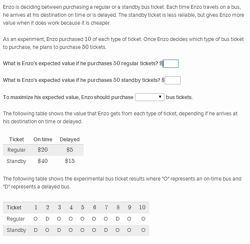| Making decisions with expected values | |
|---|---|
 | |
| Description | |
| Exercise Name: | Making decisions with expected values |
| Math Missions: | High school statistics and probability Math Mission |
| Types of Problems: | 3 |
The Making decisions with expected values exercise appears under the High school statistics and probability Math Mission. This exercise uses probability and random variables to help motivate decisions in real situations.
Types of Problems[]
There are three types of problems in this exercise:
- Which game to play: This problem describes a couple different scenarios for a game that can be played. The user has to find the expected payoffs and then use these values to determine which if any of the games they should choose to play.

Which game to play
- More profitable: This problem describes a business decision where the payoffs depend on purchases that are made. The users is asked to determine the expected value of the two scenarios and select which one is the wiser business decision.

More profitable
- Empirical decision: This problem describes a situation where a person collected actual data to model certain choices. The user is asked to determine the expected values based on this empirical data and make a decision about which path is smarter.

Empirical decision
Strategies[]
This exercise is medium to get accuracy badges, especially the first time through as the user need to get adjusted to subtleties in the problem analysis. Even if they spends time learning the nuances, the speed badges are still hard because of the amount it takes to read and fully understand each situation.
- Users should be careful to read if the problem wants the expected value of one run or several runs.
- The problem More profitable has three subtypes: insurance, virus protection, and whether or not to purchase a light.
- The problem Empirical decision has two subtypes: putting items on sale and buying certain types of tickets.
- After users learn how to do a certain subtype, subsequent ones are done similarly. It might be wise to take their time to learn how to do them carefully, then try for speed.
Real-life Applications[]
- Probability, along with decimals, percents, and fractions are used to determine the probability of a basketball player making a shot.
- Data and statistics appear in news reports and in the media every day.
- Many of the problems in this exercise could be viewed as real-life applications.
- Statistics can be seen more frequently than calculus in every day life.

